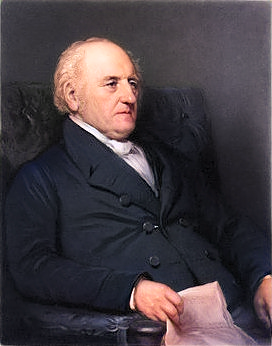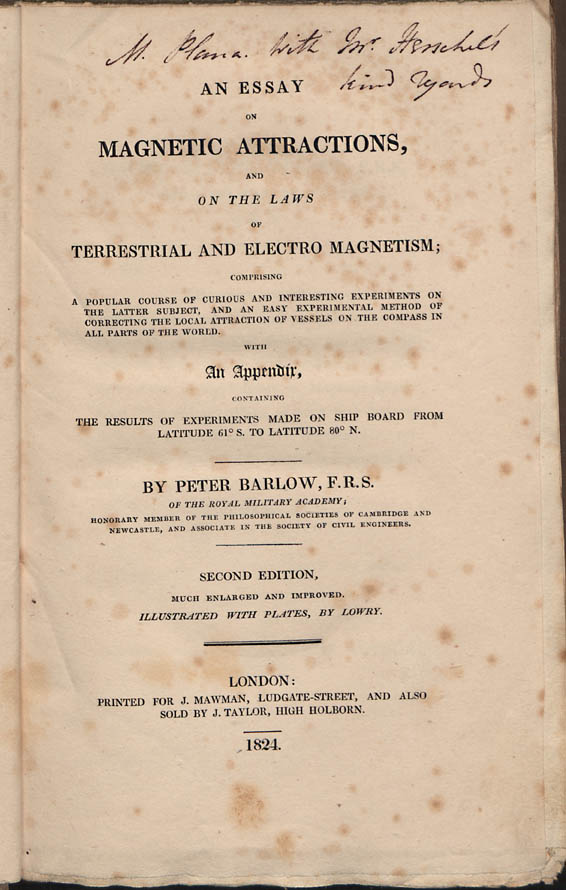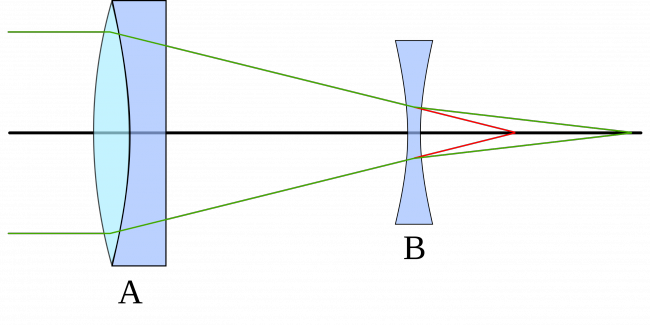
Peter Barlow (1776 – 1862)
On October 13, 1776, British mathematician and physicist Peter Barlow was born. As a mathematician, he produced important mathematical tables. However, he is still renown today for his development of two varieties of achromatic (non-color-distorting) telescope lenses, the so-called Barlow lenses.
“Opinions derived from long experience are exceedingly valuable, and outweigh all others, while they are consistent with facts and with each other; but they are worse than useless when they lead, as in this instance, to directly opposite opinions.” – Peter Barlow (1835)
Peter Barlow and the Theory of Mathematics
Despite lacking formal education, Peter Barlow became assistant mathematical master at the Royal Military Academy in Woolwich in 1801. His first research achievements mostly focused on the field of mathematics. His ‘Theory of mathematics’ was published in 1811 and he started working in the field of magnetism around 1819. Just a few years later, Barlow was elected fellow of the Royal Society. He worked on problems associated with magnetic measurements and the issue of deviation in ship compasses caused by iron pieces in the hull. In 1825, he was awarded the Royal Society Copley Medal for his method of correcting the deviation by juxtaposing the compass with a suitably shaped piece of iron used as neutralizing plate. The scientist also began conducting experiments on the influence of rotation upon magnetic and non-magnetic bodies, which was suggested by John Herschel. [1]

Peter Barlow, Essay on magnetic attractions, and on the laws of terrestrial and electro magnetism, 1824
The Barlow Lens
In the meantime, Barlow had already published his second book titled ‘New mathematical tables’, which soon became well known as ‘Barlow’s Tables’. In the book, Barlow gives factors, squares, cubes, square roots, reciprocals and hyperbolic logarithms of all numbers from 1 to 10000. Another major scientific contribution by Peter Barlow is the famous Barlow Lens,[8] which is understood as a diverging lens which, used in series with other optics in an optical system, increases the effective focal length of an optical system as perceived by all components that are after it in the system. It is mostly used in the field of astronomy and has an effect of increasing the magnification of the image. [2,3] Teleconverters are variations on Barlow lenses that have been adapted for photographic use.[2] A teleconverter increases the effective focal length of the photographic lens it is attached to, making it a telephoto lens. A true telephoto lens uses a configuration similar to a Barlow lens to obtain a shorter tube length for a given focal length.

Cone of light behind an achromatic doublet objective lens (A) without (red) and with (green) a Barlow lens optical element (B)
Later Life
During his career, Barlow also made several contributions to the theory of strength of materials and published an essay on the strength and stress of timber in 1817. This work was continued after his death by his sons, who also included a biography of their father. In 1828 he was elected to the Académie des sciences and in 1832 to the American Academy of Arts and Sciences. On several occasions in the 1830’s and 1840’s Barlow served as a royal commissioner of railroads. He was one of the first to conduct experiments and make calculations on the best shape for rails and the effect of gradients and curves. From 1826 he was an honorary member of the Russian Academy of Sciences in St. Petersburg. In 1833 Barlow combined crown and flint glass for his lenses. He became increasingly involved with the steam locomotive in later times. His sons Peter William Barlow and William Henry Barlow were distinguished engineers in the 19th century.
“230(231-1) is the greatest perfect number that will ever be discovered, for, as they are merely curious without being useful, it is not likely that any person will attempt to find a number beyond it.”
– Peter Barlow, as quoted in D MacHale, Comic Sections (Dublin 1993)
Peter Barlow died on 1 March 1862 in his home in Charlton, London at age 85.
Writings of Peter Barlow:
- Elementary Investigation of the Theory of Numbers. 1811.[11]
- New Mathematical and Philosophical Dictionary. 1814.
- Essay on the Strength and Stress of Timber and other Materials. 1817.
- Essay on Magnetic Attractions. 1820.
Barlow Lens – Complete Overview and Function, [9]
References and Further Reading:
- [1] Peter Barlow at the ENS Département de physique
- [2] The Barlow Lens at Harvard
- [3] O’Connor, John J.; Robertson, Edmund F., “Peter Barlow“, MacTutor History of Mathematics archive, University of St Andrews.
- [4] Hans Lippershey and the Telescope
- [5] Carl Friedrich Gauss – The Prince of Mathematicians
- [6] Joseph von Fraunhofer and the Solar Spectrum
- [7] Peter Barlow at Wikidata
- [8] Hartshorn, C. R. (1953). “The Barlow Lens”. In Ingalls, Albert G. (ed.). Amateur Telescope Making, Book Three. Scientific American. pp. 277–286.
- [9] Barlow Lens – Complete Overview and Function, 2019, AstroBlender @ youtube
- [10] Barlow, Peter. In: Encyclopædia Britannica. 11. Auflage. Band 3: Austria – Bisectrix. London 1910, S. 407
- [11] Peter Barlow: Theory of Numbers at MacTutor
- [12] “Barlow, Peter .” Complete Dictionary of Scientific Biography. . Encyclopedia.com. (October 7, 2022).
- [13] Works by Peter Barlow at zbMATH
- [14] Timeline of 19th Century Mathematicians via DBpedia and Wikidata






Pingback: Whewell’s Gazette: Year 3, Vol. #09 | Whewell's Ghost